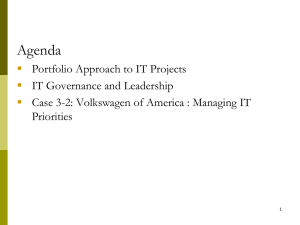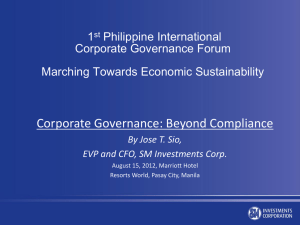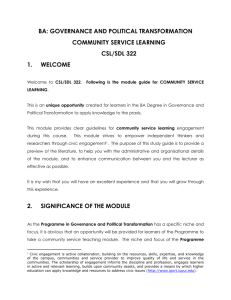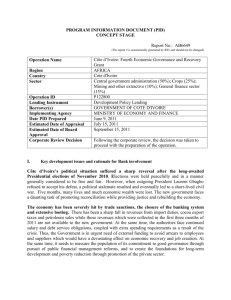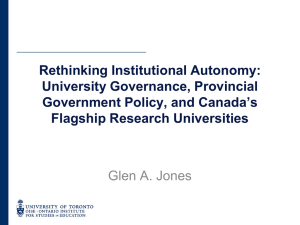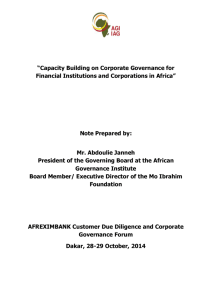Chain governance, sector policies and economic
advertisement
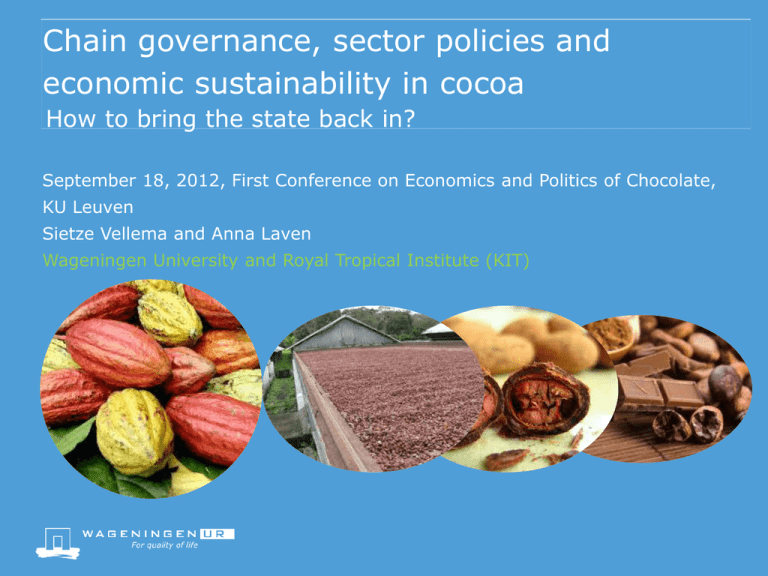
Chain governance, sector policies and economic sustainability in cocoa How to bring the state back in? September 18, 2012, First Conference on Economics and Politics of Chocolate, KU Leuven Sietze Vellema and Anna Laven Wageningen University and Royal Tropical Institute (KIT) Internationalization – question on the state Growing number of standards and certification schemes inducing news form of value chain governance and coordination Consolidation at buying end combines with fragmentation at supply end of value chain ≈ Tempered volatility in commodity markets Transition from economic governance with strong state involvement to blended forms ? Will this contribute to a process of industrial transformation ? Proposition – only with the involvement of a transformative, developmental state How to bring the state back in? The degree of state involvement and value chain coordination in economic governance ● Griffiths, A. and R. F. Zammuto (2005). Institutional Governance Systems and Variations in National Competitive Advantage: an integrative framework. The Academy of Management review 30(4): 823-842. ● Giel Ton, Sietze Vellema, Geoffrey Hagelaar, and Anna Laven (2008) Chain governance, sector policies and economic sustainability in cocoa: a comparative analysis of Ghana, Côte d’Ivoire, and Ecuador. Markets, Chains and Sustainable Development Strategy & Policy paper #7 The kind of interventions and regulations by the state ● Peter Evans (1995) Embedded autonomy: states & industrial transformation ● Whitley, R.D. (1999) Divergent Capitalisms: the social structuring and change of business systems, Oxford: Oxford University Press. ● A.H.J. (Bert) Helmsing and Sietze Vellema (eds) (2011) Value Chains, Inclusion and Endogenous Development: Contrasting Theories and Realities Ghana Ivory Coast State is involved in economic governance Ghana – partial liberalization and shifts from within revealing ownership of and investment in sector CdI – market-based governance and emergence of new sector-specific institutional arrangements in period of instability Shift focus from upgrading and compliance with standards to unravelling what happens when global value chains touch down in local realities ● Business systems theory: nature of doing business, state as economic agent, and state-business relationship ● State theory: connectedness and internal structure How to see the state? Predatory state Developmental state ● Possibilities for rent ● Shared projects of ● Explains focus on ● Invites interest in seeking degree of state involvement and reliance on markets as independent agents of change economic transformation concrete social ties that bind state to society and provide institutionalized channels for continual negotiations The concept of embedded autonomy Connectedness ● State-society relation; focus on industrial and entrepreneurial class Internal structure ● Corporate coherence Only in combination this creates a condition for effective state involvement in industrial transformation ● Internal coherence and dense external ties are complementary and mutually reinforcing Different roles of the state Custodian Demiurge More conventional roles Midwifery Husbandry More transformative roles Play role of rule maker Play role of generic producer Respond to doubts about vitality private capital Take over risky, complementary tasks Privilege policing over promotion Private actors are incapable Malleable capacities of local enterprises Global changes challenge local firms Enabling or constraining regulations Compete in markets for private goods Assist in bargaining with international capital Varying thrusts Large scale or expansionary commodity production Assist in emergence of new entrepreneurial groups / induce existing groups to venture into challenging kinds of production Greenhouses – isolated from international competition Support and prod private counterparts Agenda Survival of sector, in the case of Evans ICT, depends in part on the state’s ability to assume a blend of roles congruent with the sector’s needs - embedding ● State combines roles in the same sector – historically contingent creation ● Bureaucracies do not stand in opposition to markets ● States and societies are mutually constitutive Enhance coherence of state structure - autonomy ● Technico’s; sector specific agencies; strategically located strong groups ● Entrepreneurial bureaucrats / Institutional entrepreneurs Politics: cocoa is politicized commodity – state tied to farmers – perspective Evans shift attention to entrepreneurial classes



